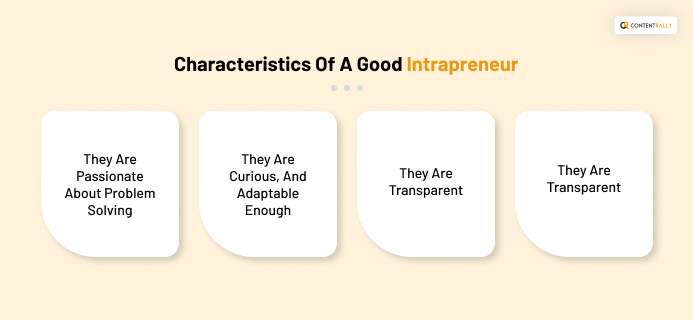Intrapreneurs and Entrepreneurs – they sound similar right?
Yeah, they do, but their definition, meaning, and characteristics are totally different from one another. Here is what we know about entrepreneurship.
Read the guide till the end to grab some rich insights.
Who Is An Intrapreneur?
Here is a concise definition.
An intrapreneur is the one who is responsible for developing an innovative project or idea within an organization.
He/she doesn’t face the outsized risks that an entrepreneur doesn’t. However, he possesses the major access to all the capabilities and resources of an established company. To be very specific, the intrapreneur gets the autonomy to work on projects having a considerable impact on organizational development.
The term intrapreneur is an amalgamation of two words like “internal” and “entrepreneur.” In 1978, it was first coined by Elizabeth S. Pinchot and Gifford Pinchot II in a white paper.
How Does Intrapreneurship Work?

You are now well aware of what is an intrapreneur. They are the employees of an organization who are given the responsibilities of working on special ideas and projects. In addition, they are given the freedom and time to develop and grow the project that an entrepreneur would.
Does this sound like they work solo? Well, not really because intrapreneurs have all the capabilities and resources of the firm at their disposal. Additionally, they have different objectives. While an entrepreneur envisions the creation of a company from level 0, the intrapreneur has a broader vision for an established entity.
The visions mainly involve radical changes to company processes, products, or traditions. He applies his skills and experiences directly to implement them on the job.
What Are The Characteristics Of A Good Intrapreneur

I hope, by now the meaning is pretty clear to you? Now, Intrapreneurship has some roles and responsibilities which require some special characteristics. Below, I have listed some of the characteristics an efficient intrapreneur must possess.
1.They Are Passionate About Problem Solving
Angels and Intrapreneurs will agree on this one. Focused intrapreneurs are the ones who are passionate about solving problems and set forth to resolve business-oriented issues.
2.They Are Curious, And Adaptable Enough
When it’s the start of a business, the intrapreneur has to play roles in several sectors such as product management, engineering, and marketing. Hence, angels look for people who are curious, adaptable, and respond to learning and development.
3. They Are Transparent
As an intrapreneur, the fastest and most efficient way to gain the confidence of your sponsors is by showing transparency. If any unwanted circumstance happens, then also, transparency needs to be maintained.
4. They Are Resilient
Intrapreneurs starting a business simply have an idea which they have to work super hard to give a shape. That’s why they need to be highly resilient since it’s likely they would come across a plethora of obstacles throughout their journey.
Pros And Cons Of Intrapreneurship
Here is a critical analysis of Intrapreneurship I have explained through an evaluation of its pros and cons. Take a look at the table below:
| Pros Of Intrapreneurship | Cons of Intrapreneurship |
| It decreases the financial risk on the innovator | The glory you enjoy is not for you only, it’s shared. |
| Makes use of all the organizational talent and resources | There is high potential for conflicts with the other members. |
| Increases the delivery of better services, products, or support. | Returns are generally less in comparison to the entrepreneurs. |
| Enlarges your reputation and develops your network. | There are a myriad of risks pertaining to failure |
| It’s a stepping stone to entrepreneurship | You will still have a boss monitoring you |
Companies Around The World Having Intrapreneurs
Here are some leading tech giants around the world who support Intrapreneurship just like different types of entrepreneurs:
- Microsoft
- Shutterstock
- Intel
- Apple
- General Motors
- Virgin
Frequently Asked Questions (FAQs):
An Intrapreneur is an employee who is given the support and authority to create a new service or product. Unlike entrepreneurs, they have no concern about whether or not the product would become a revenue source for the company.
One of the greatest examples of Intrapreneurship is Dreamworks Animation. It’s a media behemoth that gave classic works like Madagascar and Kung Fu Panda. They also offer classes on script writing to the animators.
The 3 types of Intrapreneur are as follows:
1. Advocate, coming from a customer-facing role
2. The creator coming from an internal-facing role
3. The change maker coming from an external-business-facing role.
The main difference between Intrapreneur and Entrepreneur is that an entrepreneur is a ground-up-and-go person when it comes to their own money. On the other hand, an intrapreneur is someone who starts steaming from inside a large company. That’s all about Entrepreneur Vs Intrapreneur.
The Bottom Line
That’s all we had to say about Intrapreneurs. They are overlooked often in the realm of entrepreneurship. However, with the world-changing innovation coming up, established corporations are prioritizing them.
Wanna learn how to become an intrapreneur and Intrapreneur Vs Entrepreneur in more detail? Then keep an eye out on our website as we will be coming up with a guide to that.
Read More:






















